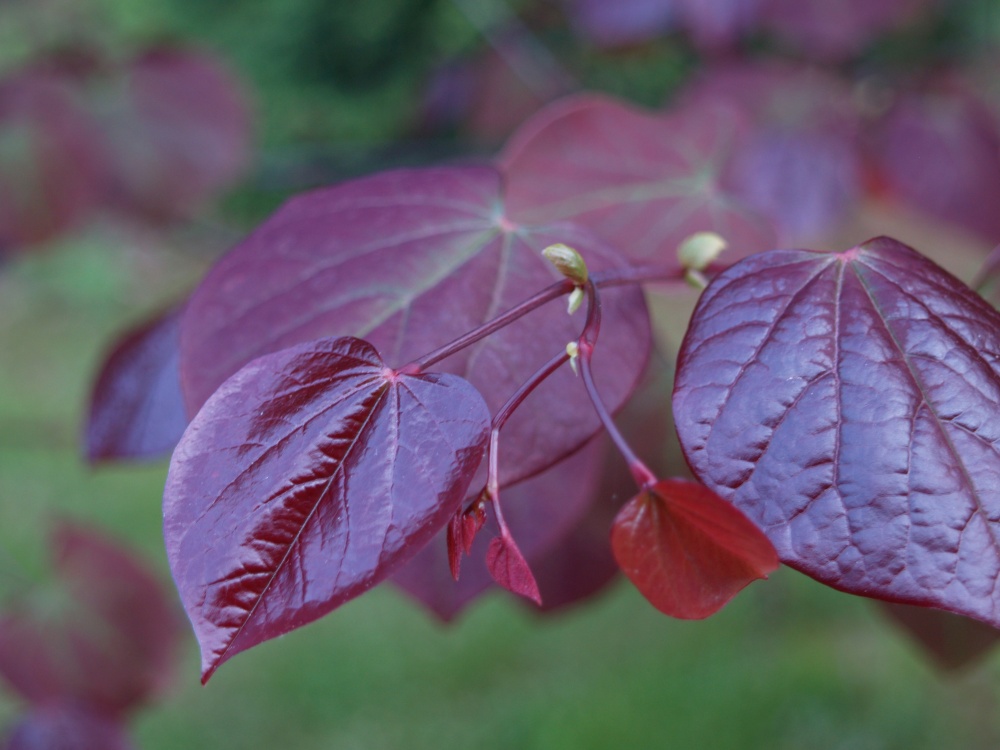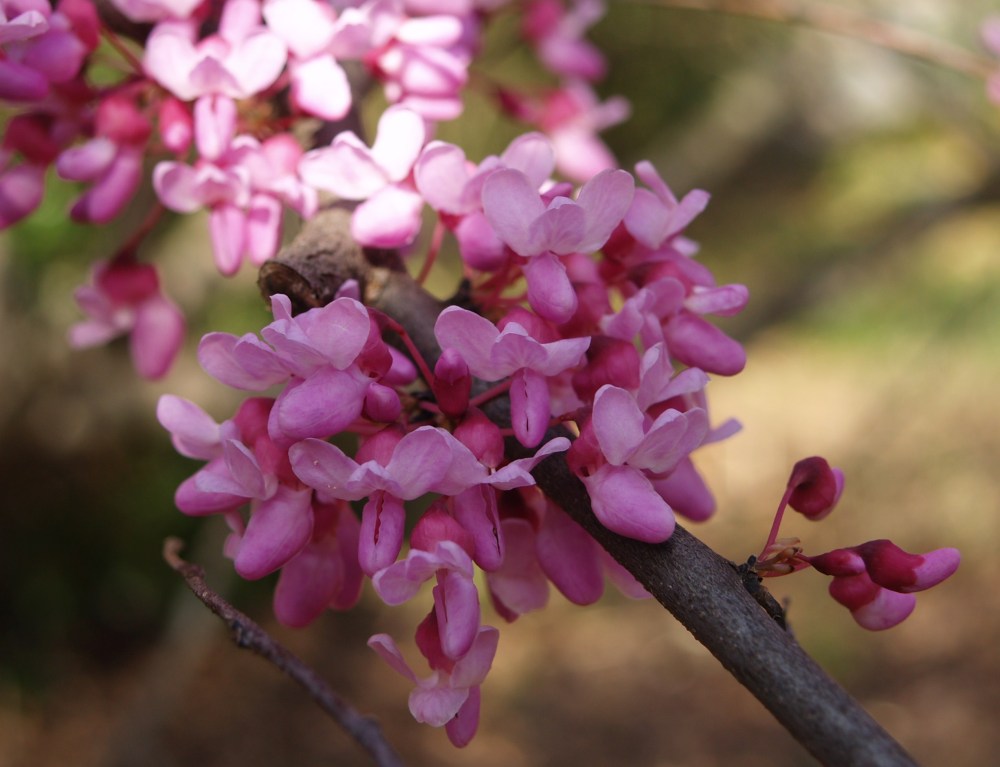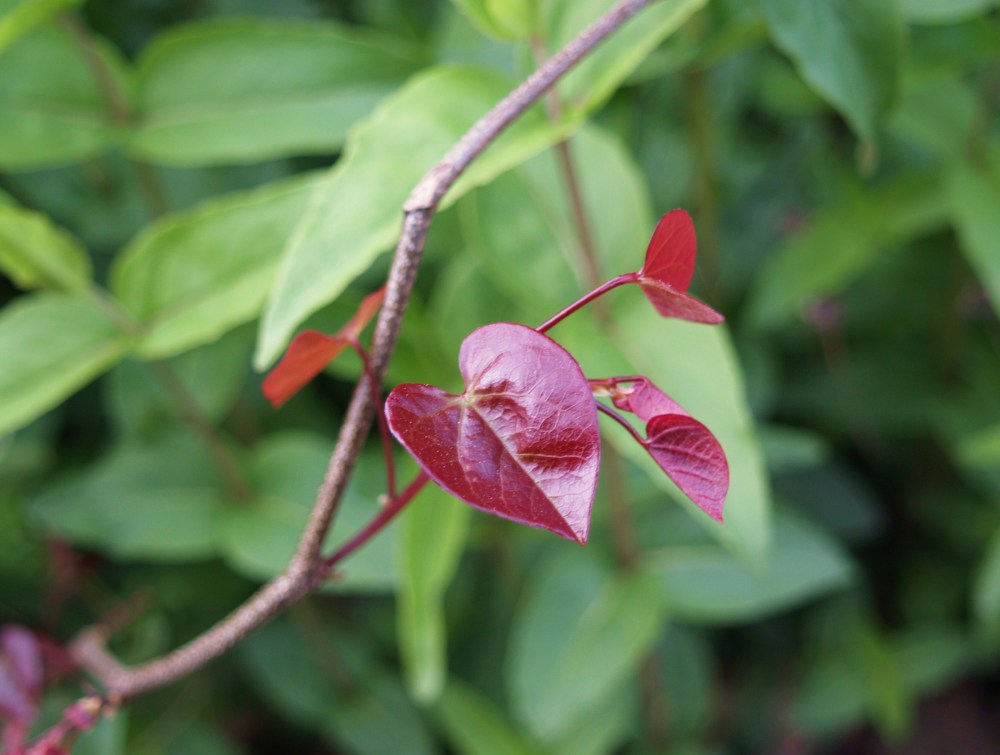In my garden I’ve planted a bunch of redbuds (Cercis canadensis), but none are the standard green leafed variety. I have nothing against green. There is a green leafed weeping variety (‘Lavender Twist’), but the others have variegated foliage (‘Silver Cloud’), or yellow (‘Hearts of Gold’). ‘Forest Pansy’ leaves emerge a glossy reddish-purple (below), and then turn to purple in May. Through the heat of the summer the foliage will often fade to reddish-green, though it remains quite attractive.
The various colored leaf versions of redbud are mostly natural mutations, and not hybrids where the genes of one tree are crossed with another. Whenever a redbud seedling pops up in my garden, it always (almost always) has green leaves, but if there were a thousand seedlings it’s likely that a few would have a different leaf color or other variation of some sort. When an experienced plantsman with a keen eye spots an anomaly he will flag the tree and grow it on to see if the unique characteristics are stable, but also to see if the tree has sufficient vigor to survive in a garden.
If all grows well, the plantsman will nurture the tree for years until he can tell if the tree is significantly different and better than existing varieties. If so, is there a market to sell the tree? If, if if, there are lots of if’s, but for most interesting mutations there are more but’s so that the tree remains a one-of-a-kind. So, now the plantsman has figured that the tree is different, arguably better, and with has some degree of marketability. How do we make more?
This is not so simple. Most seedlings from the tree will look nothing like it, so the tree must be cloned. Some plants are propagated by tissue culture where plant tissue is grown in a laboratory, but a redbud is likely to have a small cutting taken that will be grafted onto the root stock of a plain green redbud. The process is slow, and it can take a decade to grow the first batch of trees ready for market.
I’ve recently discovered a glossy red leafed redbud seedling (below) growing in my garden. Is it ‘Forest Pansy’? There’s little doubt that part of the new tree’s genetics came from the nearby ‘Forest Pansy’, but there’s another half that contributes to the genes of this tree, so while the seedling might look like a ‘Forest Pansy’, it’s very unlikely that the trees will be identical.
What will I do with this little red leafed redbud? It has sprouted about five feet from a Japanese maple, and I’m not tempted even slightly to move the maple. So, the two are too close together. I suppose I’ll let the redbud gain a bit of strength this spring, then dig it out when the ground is damp and more rain is expected to reduce shock from the transplant. I’ll find a spot to plant it with a little more space that’s partially shaded, and then I’ll wait. After a year or two there might be enough information to decide whether this young tree is just a curiosity, or if it has some value.
Most likely the red will fade (probably worse than ‘Forest Pansy’), or there will be some other defect so that this redbud’s only value will be inspiration for stories that I tell. There are hundreds of Japanese maple seedlings that pop up in the garden every year, and with genetics of the twenty four varieties in the garden a few could turn out to be something of interest. But, other than a few seedlings I’ve given away to friends and family, the others get pulled out and discarded. What am I going to do with a few hundred seedlings each year? The same fate is likely for my little red leafed redbud.
I’m envious. Forest Pansy isn’t quite hardy enough to grow here, though I have friends who’ve tried.
Love your updates, always looking forward to them.
I love your writings and your pictures. I have a redbud seedling my husband brought home to me and I haven’t a clue what to do with it. Any suggestions, do I plant it in the yard or put it into a pot and let it root more then transplant it to yard?
The advantage of potting the seedling is that it is more likely to get careful treatment, and with a good soil mix the roots should spread quickly. If you pot it this spring I would not plant it until trees begin to go dormant in the autumn. If you have a spot in the garden to plant it now, there’s no reason not to, but if it’s very small, or if it’s bare root, it will require more attention to get it through the summer.
The honeybees like redbuds so much, it’s a shame you throw away the seedlings.
Interesting, I haven’t noticed honeybees around my redbuds. I’m afraid if I didn’t cull out seedlings that pop up in the garden it would turn to a forest of redbuds and Japanese maples in a few years. The garden is nearly a forest already, but there’s at least a bit of order. Seedling pop up anywhere and everywhere, so someone has to keep things in some semblance of order.
Oh, yeah, you have to keep them thinned out in your garden, but I’m a beekeeper, and if I could I’d plant thousands of them within a 3 mile radius of my bees. I’m actually trying to germinate some redbud seeds now, but they are tough. You may not have any/many feral bees in your area, mites and other things have almost wiped out the bees a few times recently, but redbud is an early bloomer and provides bees a great source of nectar and pollen for early Spring buildup. BTW, I’m in Arkansas now, but I grew up in Arcola, Va. I worked at the Meadows Farms on Rt. 50 when they first built it in like 1987 or 1988 I think. Where my house was is now called the South Riding development or something.
It’s great to hear from one of our old timers. I hesitate to admit that I started in 1976. Our offices now are just across the highway from South Riding.
Unfortunately, I’ve noticed the dropoff in honeybees through the years, though I did see an increase last year. In my garden there are many bumblebees, and plenty of wasps, hornets, and hoverflies, but not as many bees over the past decade. Thanks for writing.